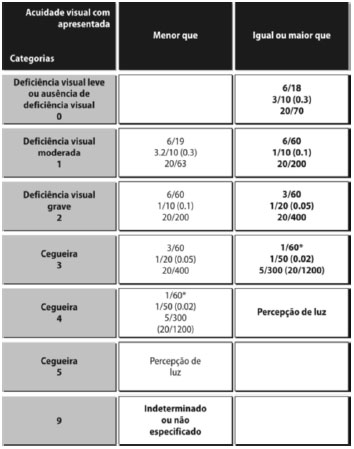Maria Aparecida Onuki Haddad1; Marcos Wilson Sampaio2; Helder Alves da Costa Filho3; Milton Ruiz Alves4; Maria de Fátima Néri Góes5; Keila Monteiro de Carvalho6; Dr. Alexandre Costa Lima de Azevedo (in memoriam)
DOI: 10.17545/e-oftalmo.cbo/2015.17
ABSTRACT
The terminology adopted by professionals in the field of low vision rehabilitation, as well as in topics that are pertinent to the work of professionals and healthcare practices is of paramount importance for collaboration on the guidelines of actions geared towards the inclusion of the visually impaired person, consistency of professional performance; disseminating the “gold standard” of activity in the field of low vision; discussing interdisciplinary activities and roles of various professionals and overall improved quality of services.
This publication will shed light on the measures, terminology, and definitions of visual impairment.
Keywords: Visual Rehabilitation. Visual Impairment. Care Standards.
RESUMO
A terminologia a ser adotada pelos profissionais da área de reabilitação da baixa visão e também de assuntos pertinentes à atuação de profissionais e serviços é de suma importância para: colaborar nas diretrizes de ações voltadas para a inclusão da pessoa com deficiência visual; colaborar com a atuação profissional; disseminar o “padrão-ouro” de atuação na área da baixa visão; discutir a atuação interdisciplinar e papéis dos diversos profissionais; melhoria da qualidade de serviços. Esta publicação esclarecerá sobre as medidas, terminologia e definições da deficiência visual.
Palavras-chave: Reabilitação Visual Deficiência Visual Diretrizes
INTRODUCTION
The decision of which terminology to use in the field of visual impairment has several approaches, according to the proposition of the classifications and definitions developed. This leads to difficulties in communication between professionals and services because different terminologies may be adopted1.
It is necessary to standardize concepts, definitions, and terminologies to improve communication between scientific researchers and other medical professionals2.
In the globalized world, the use of a single set of terminology allows for the comparison of data from studies performed in different countries and epidemiological regions2.
This article presents the terms and definitions recommended by the main international classifications used in the area of visual rehabilitation.
ICD-10
According to the tenth revision of the International Statistical Classification of Diseases and Related Health Problems (ICD-10), low vision is defined as visual acuity with best possible correction <0.3 and >equal to 0.05 (categories of visual impairment 1 and 2); blindness is determined by values <0.05 (categories 3-5).
Patients whose visual field is between 5° and 10° around the fixation point should be classified as category 3 and patients whose field is up to 5° around the fixation point should be included in category 4, even if central acuity remains uncompromised4.
This categorization is based on the recommendations made in 1972 by the World Health Organization (WHO) Study Group on the Prevention of Blindness and was included in the 1975 ICD-95.
The ICD-10 presents the following categories of visual impairment:
• H 54.0 Blindness, binocular
Visual impairment categories 3, 4, or 5 in both eyes
• H 54.1 Blindness, one eye, low vision other eye
Visual impairment categories 3, 4, 5 in one eye, with categories 1 or 2 in the other eye. eye
• H 54.2 Low vision, both eyes
Visual impairment categories 1 or 2 in both eyes.
The WHO is currently conducting discussions for the eleventh revision of the ICD, which is to be published in 2015. Thus, some updates have been proposed and will possibly be incorporated into the latest revision. The recommendations and proposals that could be included in ICD-11 in 2015 are:6 the use of the term “presenting visual acuity” in place of “visual acuity with best possible correction”; exclusion of the term “low vision” and use of the visual impairment categories 1, 2, or 3.
Changes to the H 54 subcategories:
H54-Visual impairment including blindness (binocular or monocular)
H 54.0 Blindness, binocular
(Visual impairment categories 3, 4, and 5)
H 54.1 Severe visual impairment, binocular
(Visual impairment category 2)
H 54.2 Moderate visual impairment, binocular
(Visual impairment category 1)
H 54.3 Mild or no visual impairment, binocular
(Visual impairment category 0)
H 54.4 Blindness, monocular
(Visual impairment categories 3, 4, 5 in one eye and categories 0, 1, 2, or 9 in the other eye.)
H 54.5 Severe visual impairment, monocular
(Visual impairment category 2 in one eye and categories 0, 1, or 9 in other eye.)
H 54.6 Moderate visual impairment, monocular
(Visual impairment category 1 in one eye and categories 0 or 9 in other eye.)
H54.9 Unspecified visual impairment (binocular)
(Visual impairment category 9)
ICF
The current version of the International Classification of Functioning, Disability and Health (ICF) differs substantially from the 1980 version (which assessed the impact of the disease on the individual’s health condition) in the representing the interrelationships between functionality and incapacity, having transformed itself into a classification of health components and their multiple interactions. It relies on a biopsychosocial approach7.
The significance of a visual condition for an individual depends on his/her interaction with social, environmental, psychological, and family- and work-related factors.8,9
The ranking is based on an alphanumeric system in which each letter (prefix) corresponds to one of the subdivisions:10
b (body) = Body Functions
s (structure) = Body Structures
d (domain) = Activities and Involvement
e (environment) = Environmental factors
The letters are followed by numbers representing different levels of magnitude.
It is important to note that the ICF does not classify individuals, but describes their situation within health or health-related domains. This description is always made within the context of personal and environmental factors. The use of ICF can intensify the support to individuals with disability or limitation.
It may help to identify the main source of the disability, whether it is in the environment (existence of a barrier or lack of a facilitator), in the individual's own limited ability, or a combination of these factors.
In the case of visually impaired individuals, ICF can help identify whether the main disability issue is in the structure of the eye or in functional vision, depending on the pathology presented.
Interventions can then be chosen accordingly, with more satisfactory results.
ICO
The International Council of Ophthalmology (ICO) is responsible for the most recent classification, drafted in April of 2002 in Australia, aiming standardize the terminology, so that it can be used by both medical and non-medical professionals who work with visually impaired individuals10.
The report suggests that the following terminology be adopted by the ophthalmic community:
• Blindness: to be used only for total vision loss and for conditions where individuals have to rely predominantly on vision substitution skills
• Low Vision: to be used for lesser degrees of vision loss, where individuals can significantly benefit from vision enhancement aids and devices
• Visual Impairment: to be used when the condition of vision loss is characterized by a loss of visual functions (such as visual acuity, visual field, etc.) at the organ level. Many of these functions can be measured quantitatively.
• Functional Vision: to be used to describe a person’s ability to use vision in Activities of Daily Living (ADL). Presently, many of these activities can be described only qualitatively
• Vision Loss: to be used as a general term, including both total loss (Blindness) and partial loss (Low Vision), characterized either on the basis of visual impairment or by a loss of functional vision.
For reporting the prevalence of vision loss in population studies and clinical research, the following definitions are recommended:
• Normal vision ≥ 0.8
• Mild visual loss <0.8 and ≥0.3
• Moderate visual loss <0.3 and ≥0.125
• Severe visual loss <0.125 and ≥0.05
• Profound visual loss <0.05 and ≥0.02
• Near-total visual loss (near blindness) <0.02- ≥no light perception (NLP)
• Total visual loss (total blindness) NLP
BRAZILIAN LEGISLATION
In Brazil, Decree No. 5296 of 2 December 2004 regulates Law No. 10,048, of November 8, 2000, which gives priority service to the patients the law specifies, and Law No. 10098 of 19 December 2000, which establishes general rules and basic criteria for promoting accessibility for patients with disabilities or reduced mobility, and other provisions. Article 70 and article 4 of Decree No. 3298, of 20 December 1999, establish the following terminology for visual impairment:1,7
• blindness: where visual acuity is ≤0.05 in the better eye with the best optical correction;
• low vision: where visual acuity is between 0.3 and 0.05 in the better eye with the best optical correction;
• cases in who the sum of the visual field measurement in both eyes is ≤60°;
• or the simultaneous occurrence of any of the above conditions.
It is important to note that Decree 5296 was based on ICD-10, except for the measurement of visual field.
In September 2003, after a consulting project that aimed to develop standards to characterize vision loss and visual functionality, the WHO proposed the combined use of the classifications listed in ICD-10 and the International Council of Ophthalmology, according to the following table:

CONSENSUS OF THE BRAZILIAN SOCIETY FOR LOW VISION
Considering the classifications presented, the Consensus recommends that the following classifications should be adopted based on their reason for use:
• For population and clinical research studies: the use of definitions proposed by ICD-10 is recommended; in cases when more detail is required, the visual loss categories proposed by the ICO should be referred.
• In reports made by healthcare professionals, the use of the ICD-10 and Decree No. 5296 (December of 2004) definitions is recommended for legal purposes.
• In the evaluation of visual function regarding the actions developed for individual rehabilitation: the Bangkok definition (1992) may be adopted.
• The definitions chosen may not be used as eligibility criteria for individual care in visual rehabilitation services. Broader aspects should be considered: personal aspects, visual functions (beyond visual acuity), and performance of daily activities as well as participation in society and within their personal, family, and social context.
• The corrected visual acuity values are considered in clinical practice. The guidelines for use of presenting visual acuity (which may not be corrected) are justified both for epidemiological studies and for those that assess the prevalence of visual impairment.
• The term visual impairment should be used both for blind individuals and for those with low vision.
• The term subnormal vision, as a terminology widely used in this setting, can be used interchangeably with the term low vision.
The use of the following categories, defined in ICD-9 and ICD-10, is recommended:
• Low vision: between <0.3 and ≥0.05
• Blindness: <0.05
As the gold standard for the measurement of visual acuity in population studies and clinical research, the Consensus recommends the adoption of the ETDRS protocol of the National Eye Institute, National Institutes of Health, United States.
An ophthalmologist’s role is to evaluate the visual condition of an individual to understand the specific needs for improving the performance of activities that depend on the best visual resolution, to understand other needs of the individual with low vision (within his/her social situation), to refer patients to other professionals in the visual rehabilitation area (e.g., orientation and mobility, early intervention, and psychology professionals), and indicate and prescribe optical aids for low vision (optical correction of refractive errors when necessary, as well as special optical aids, such as telescopic systems and magnifying glasses). The ophthalmologist, according to the characteristics of the various visual functions studied, may also indicate the use of non-optical aids (for material and environment modifications), as well as video amplification and computer aids.
The assessment of individuals with low vision is a continuous process that follows the progression of the underlying ocular disease, the refractive changes, the development of each individual, and the modification in their interests. Therefore, ophthalmic reassessment must be periodic, at the ophthalmologist’s and service’s discretion, on an ophthalmologic case-by-case basis.
REFERENCES
1 Consenso da Sociedade Brasileira de Visão Subnormal. Sociedade Brasileira de Visão Subnormal. Relatores: Haddad MAO; Sampaio MW; Costa Filho HA; Carvalho KMM; Azevedo ACL. RJ, Selles & Henning Comunicação lntegrada;2010.
2 Sampaio MW, Haddad MAO. Baixa visão: manual para o oftalmologista. Rio de Janeiro:Guanabara Koogan; 2009.176p.
3 Instituto de Migraciones y Servidos Sociales (IMSERSO). Valoraciones de las situaciones de minusvalia, Madrid: IMSERSO, 1 .ª edición: 2000: 316.
4 Organização Mundial da Saúde - Classificação Internacional de Doenças e Problemas Relacionadas à Saúde - Décima Revisão. São Paulo: Edusp, 1993.
5 World Health Organization. Consultation on development of standards for characterization of visual loss and visual functioning. Geneva: WHO/PBL/03.91 ;2003.
6 World Health Organization. Change the definition of blindness. Disponível no endereço eletrônico http://www.who.int/blindness/ChanaetheDefinitionofBlindness.pdf
7 Haddad MAO; Sampaio MW. Reabilitação da Pessoa Com Deficiência Visual. In Rodrigues MLV; Kara-José N. Perfil Epidemiológico das principais causas de cegueira no Brasil. Tema Oficial do XX Congresso Brasileiro de Prevenção da Cegueira e Reabilitação Visual. Rio de Janeiro, Cultura Médica, 2012:131 -160.
8 Organização Mundial da Saúde. Classificação Internacional de funcionalidade, incapacidade e saúde. São Paulo: Editora da Universidade de São Paulo; 2003.
9 Buchalla CM. Organização Mundial da Saúde e Família de Classificações Internacionais. In: Sampaio MW, Haddad MAO, Costa Filho HA, Siaulys MOC. Baixa visão e cegueira. Os caminhos para a reabilitação, a educação e a inclusão. Rio de Janeiro: Cultura Médica Guanabara Koogan; 2010. P:17.
10 Azevedo ACL. Legislação e Deficiência Visual. In: Alves MR; Nishi M; Carvalho KM; Ventura LMVO; Schellini SA e Kara-José N. Refração Ocular: Uma Necessidade Social. Tema Oficial do XXI Congresso Brasileiro de Prevenção da Cegueira e Reabilitação Visual e II Congresso de Oftalmologia de Língua Portuguesa. Rio de Janeiro, Cultura Médica; 2014:17-83.





Fonte de financiamento: declaram não haver.
Conflito de interesses: declaram não haver.
Received on:
April 23, 2015.
Accepted on:
May 18, 2015.